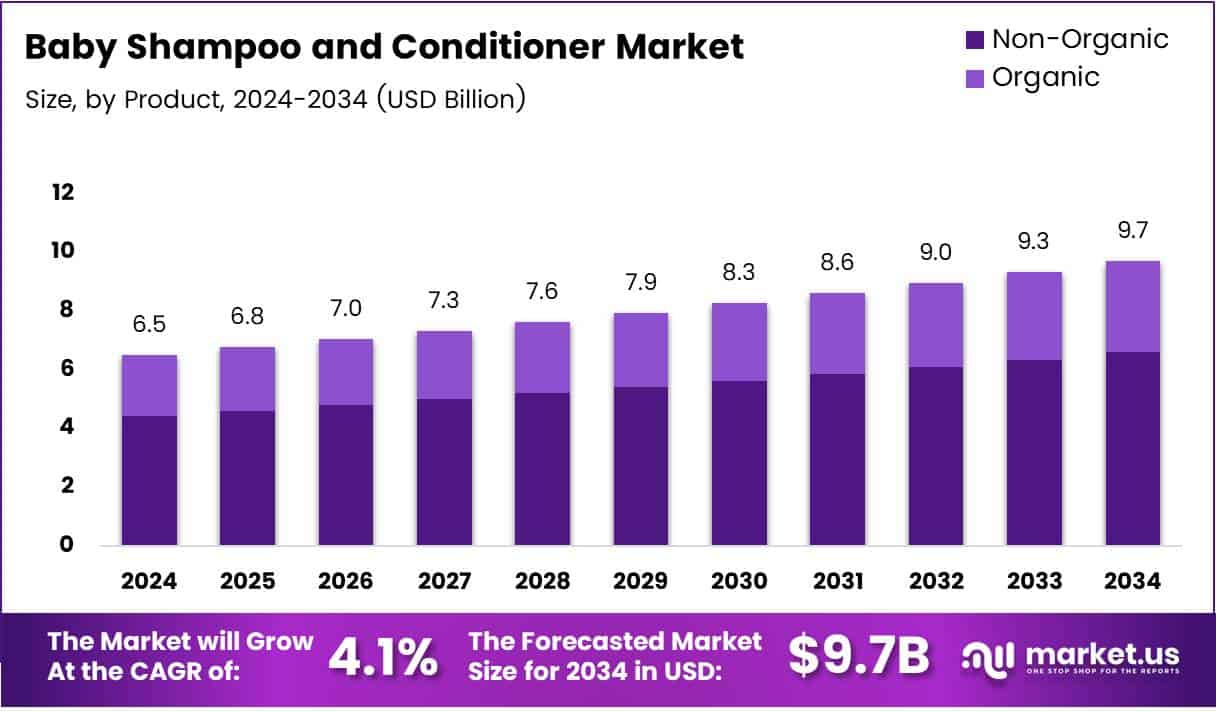The global baby shampoo and conditioner market is on a strong growth trajectory, projected to reach US$ 9.7 billion by 2034, up from US$ 6.5 billion in 2024, reflecting a CAGR of 4.1% during the forecast period (2025–2034).
The increasing focus on infant hygiene, natural product formulations, and the influence of social media marketing are transforming the baby care landscape globally. With birth rates rising across key regions and greater awareness among parents about safe, skin-friendly products, the market is evolving to offer both traditional and organic solutions.

Table of Contents
Key Takeaways
- The market is expected to grow at a CAGR of 4.1% from 2025 to 2034.
- Non-Organic products dominate the segment, holding 80.1% market share in 2024.
- Offline distribution channels lead the market, especially in Asia Pacific and Latin America.
- Asia Pacific captured 56.8% of global revenue in 2024, valued at US$ 3.7 billion.
- Parents increasingly prefer natural, chemical-free baby care products, boosting organic demand.
- India’s baby care product exports rose by 30% between Oct 2023 and Sept 2024, per Volza.
Key Market Segments
By Type
- Non-Organic
- Organic
By Distribution Channel
- Offline
- Online
Drivers
Rising Global Birth Rates and Parental Awareness Fuel Demand
According to the CDC, the U.S. saw 3,622,673 births in 2024, a 1% increase from the previous year. Similarly, birth rates in Asia and Latin America surged, with Asian and Hispanic women seeing 5% and 4% increases respectively, according to The Economic Times. These trends have directly amplified demand for baby care products, particularly shampoos and conditioners. Parents are now more inclined toward buying gentle, dermatologically-tested products that ensure infant safety and hydration.
Use Cases
Daily Hygiene with a Focus on Gentle Care
Baby shampoos and conditioners are essential in the daily grooming routines of infants. Non-organic versions remain popular due to affordability and accessibility, while organic options are increasingly preferred by eco-conscious families. These products not only clean but also protect sensitive baby skin and hair from irritation, dryness, and allergies.
Specialized Formulations for Sensitive Skin
With increasing skin sensitivities among newborns, there is demand for hypoallergenic and tear-free solutions. Brands like Johnson & Johnson and Burt’s Bees have gained trust with formulations free from parabens and sulfates, focusing on child-safe ingredients that minimize adverse reactions.
Take advantage of our unbeatable offer - buy now!

Major Challenges
High Price of Premium and Organic Products
Organic and hypoallergenic formulations, while gaining traction, remain inaccessible to a broader consumer base due to their high cost. In price-sensitive regions such as parts of Africa and Southeast Asia, this limits the potential customer base. The lack of affordability for chemical-free and eco-labeled products continues to pose a barrier for widespread adoption.
Business Opportunities
Expanding Export Markets and E-commerce Penetration
India exported 4,880 baby care shipments between Oct 2023 and Sept 2024—a 30% YoY growth. The U.S., Peru, and Kazakhstan emerged as key buyers, showing how international markets present untapped potential. Additionally, while offline remains dominant, online distribution channels are gaining ground among tech-savvy parents seeking product reviews and convenience.
Natural Product Innovation and Clean Label Movement
Brands have an opportunity to capitalize on growing demand for plant-based, organic formulations. Transparency in labeling and sustainability-focused production processes can help capture health-conscious consumers. Innovation in packaging, tear-free technology, and soothing fragrances also offer scope for differentiation.
Regional Analysis
Asia Pacific continues to dominate with 56.8% market share, driven by high birth rates, urbanization, and rising disposable income. Countries like India and China are investing in maternity and child welfare initiatives, fueling market expansion.
North America follows with a strong demand for hypoallergenic and dermatologically-tested baby products. The presence of global players and a large working-parent population supports premium product sales.
Europe is focused on eco-friendly and organic options, with stringent regulations promoting clean ingredient labels. Consumers here demand sustainable and recyclable packaging, which adds to brand differentiation.
Latin America is witnessing growing demand for chemical-free products, especially in Brazil. As consumer income grows, so does the appetite for higher-quality baby care products.
Middle East & Africa is emerging, with rising awareness and income levels contributing to increased demand, especially for natural baby hygiene products in South Africa and the UAE.
Recent Developments
- October 2024: Millennium Babycares raised US$14.5 million in funding led by Bharat Value Fund for product innovation and expansion.
- October 2024: Bharat Value Fund invested INR 122 crore in Millennium Babycares to grow its premium baby care footprint.
- April 2025: ITC acquired Mother Sparsh, enhancing its portfolio in the natural and organic baby care category.
Conclusion
As the global baby shampoo and conditioner market continues to grow, driven by increasing birth rates and parental preference for safe and natural care, both traditional and emerging brands have a unique opportunity to scale. Companies that invest in organic innovation, transparent labeling, and regional market expansion are well-positioned to thrive in this evolving landscape. With Asia Pacific leading the way, the next decade promises both steady growth and exciting innovation.
Discuss your needs with our analyst
Please share your requirements with more details so our analyst can check if they can solve your problem(s)



